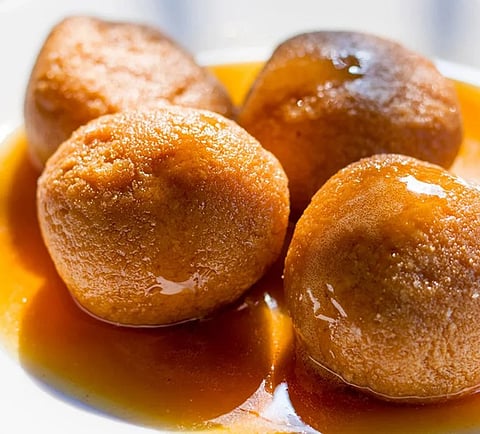
- HOMEGROWN WORLD
- #HGCREATORS
- #HGEXPLORE
- #HGVOICES
- #HGSHOP
- CAREERS
- ABOUT US
- CONTACT US

As winter sets in and temperatures drop below 14℃ in Bengal, the date palm trees found in the Bengali countryside produce a precious, sweet sap cherished by all Bengalis. This date palm sap is to Bengalis what nectar is to bees — it is the precursor to Nolen Gur, a highly sought-after seasonal sweetener in Bengal.
Nolen Gur, or 'new jaggery', is produced by simmering, reducing, concentrating, and caramelising the date palm sap over a slow wood fire for hours. Based on how long the concentration and caramelisation process is continued, the sap yields two kinds of gur or jaggery: the viscous, liquid jhola gur or 'dripping jaggery', and the grainy, solid patali gur or 'disc jaggery'. The thick, viscous reddish brown jhola gur is usually consumed as is with flatbread or puffed rice, while the solid, grainy patali is used to sweeten everything from traditional Bengali sweets like rosogolla and jolbhora sondesh to deserts like payes (rice pudding) and peethay (rice flour dumplings). Patali can also be stored for long-term use during the rest of the year owing to its long shelf-life.
Historically, Nolen Gur was prepared by a peasant community known as 'shiuli' or 'gachia' across Bengal. Boys and men from the community would climb the trees in the evening between December and February, when the biting cold temperature precipitates the sap production, and tap — or carefully scrape and carve — the date palm trees to collect the sap. Drip by drip, the sap would accumulate in an earthen pot overnight and would be taken home the next morning before dawn breaks. Then, the sap is slow-cooked over a wood fire — in a technique known as 'jwaal deowa', which involves simmering and stirring the sap continuously so it caramelises evenly and does not burn — to produce Nolen Gur.
For centuries, Nolen Gur has been a staple in Bengal's seasonal winter delicacies, delighting Bengalis of all ages with its natural sweetness, which, unlike sugar, does not have a tangy aftertaste. Nolen Gur tastes sweet, with a woody caramel aftertaste because of the long, slow caramelisation process. It also gives foods a pale reddish brown colour — a visual cue that they have been sweetened with Nolen Gur.
But as average winter temperatures rise due to climate change and shiulis search for other, more gainful, year-round employment, quality Nolen Gur is getting harder to find. With rising demand, over-harvesting of the sap without giving the trees adequate rest between tapping has also led to a drop in the quality of sap, ergo a drop in the quality of Nolen Gur. Much of the Nolen Gur available in the market today is adulterated with caramelised cane sugar. This does not augur well for the future of this long-cherished winter delicacy. Will we lose Nolen Gur to enshittification as well?
If you enjoyed reading this, here's more from Homegrown:
A Taste Of Winter: The Many Pleasures Of Sweet Bengali 'Peethay' Pancakes & Dumplings
'Molasses' Brings An Ingredient-Focused, Immersive Slow Dining Experience To Pondicherry
Kashmir's Noon Chai Is A Pink & Salty Delight That Holds Centuries Of Heritage
